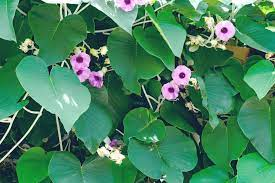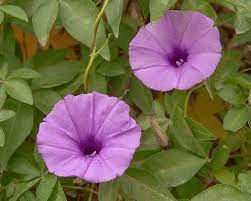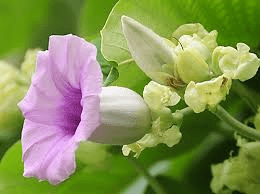Argyreia nervosa, commonly known as Hawaiian baby woodrose, is a perennial climbing vine native to the Indian subcontinent, Southeast Asia, and Australia. The plant belongs to the Convolvulaceae family, which also includes morning glory. Hawaiian baby woodrose is well-known for its seeds, which contain psychoactive compounds.
The seeds of Argyreia nervosa have a long history of traditional use in various cultures for their hallucinogenic properties. The primary psychoactive substances found in the seeds are ergine (also known as d-lysergic acid amide or LSA) and other related alkaloids. Ergine is structurally similar to lysergic acid diethylamide (LSD), but its effects are generally milder.
Consumption of Hawaiian baby woodrose seeds induces psychoactive effects, including altered perception, visual distortions, and changes in thought processes. However, it’s important to note that the use of these seeds also carries risks and potential side effects. Nausea, vasoconstriction, and other adverse reactions have been reported, and the legality of possessing or using the seeds varies in different regions.
Due to the potential for unpredictable effects and health risks associated with the consumption of Hawaiian baby woodrose seeds, caution and responsible use are strongly advised. Additionally, legal regulations regarding the possession and use of these seeds should be thoroughly researched and adhered to in any given jurisdiction. As with any psychoactive substance, individuals should be aware of the potential risks and make informed decisions about their use.
The Botanical Description of Argyreia Nervosa
1. Plant Morphology: Argyreia nervosa, commonly known as Hawaiian Baby Woodrose, is a climbing vine characterized by heart-shaped leaves and attractive trumpet-shaped flowers. The plant’s foliage exhibits a vibrant green hue, providing an appealing aesthetic.
2. Leaf Structure: The leaves of Argyreia nervosa are large and cordate, typically ranging from 6 to 12 inches in width. They have a smooth texture and are deeply lobed, contributing to the distinctive appearance of the plant.
3. Flower Characteristics: The plant produces striking funnel-shaped flowers with a range of colors, including shades of pink, purple, and white. These flowers are noteworthy for their size and intricate details, enhancing the ornamental value of Argyreia nervosa.
4. Growth Habit: Argyreia nervosa is a vigorous climber that can reach considerable heights. The plant often wraps itself around supporting structures, showcasing its adaptability and versatility in various environments.
5. Root System: The root system of Argyreia nervosa is well-developed, providing stability and anchorage for the climbing vine. The roots play a crucial role in nutrient absorption and overall plant health.
6. Seed Characteristics: The seeds of Argyreia nervosa are a key feature, as they contain natural compounds of interest. The seeds are enclosed in distinctive pods, and their appearance adds to the overall allure of the plant.
7. Aromatic Qualities: Argyreia nervosa is known for its aromatic qualities, with a subtle yet distinctive fragrance emanating from its flowers. This aromatic aspect contributes to the sensory experience when encountering the plant.
The Geographic Distribution of Argyreia Nervosa

1. Native Regions: Argyreia nervosa is indigenous to certain regions of Southeast Asia, including countries like India and Sri Lanka. In its native habitats, the plant thrives in a tropical climate with ample sunlight and well-drained soil.
2. Naturalized Areas: Due to its ornamental qualities and adaptability, Argyreia nervosa has naturalized in various other tropical and subtropical regions worldwide. It can be found in parts of Africa, Australia, and the Americas.
3. Climatic Preferences: The geographic distribution of Argyreia nervosa is closely linked to its preference for warm and humid climates. The plant flourishes in areas with temperatures that rarely drop below 10 degrees Celsius (50 degrees Fahrenheit).
4. Altitudinal Range: Argyreia nervosa is typically found at lower altitudes, thriving in coastal regions and lowland areas. Its altitudinal range is a key factor influencing its distribution and growth patterns.
5. Habitat Types: The plant is adaptable to various habitat types, including forests, grasslands, and disturbed areas. It can be observed growing along riverbanks and in open landscapes, showcasing its resilience.
6. Invasive Potential: In some non-native regions, Argyreia nervosa has displayed invasive tendencies, spreading rapidly and outcompeting local vegetation. This behavior has led to concerns in certain ecosystems.
7. Cultivation as Ornamental Plant: Beyond its natural distribution, Argyreia nervosa is cultivated as an ornamental plant in gardens and landscapes worldwide. Its visual appeal and unique characteristics make it a sought-after addition to tropical and subtropical gardens.
The Chemical Composition of Argyreia Nervosa
1. Ergoline Alkaloids: Argyreia nervosa is notable for containing ergoline alkaloids, including lysergic acid amide (LSA). These compounds are known for their psychoactive properties, contributing to the plant’s historical use.
2. Other Alkaloids: In addition to ergoline alkaloids, Argyreia nervosa may contain other alkaloids with varying effects. These compounds contribute to the overall chemical diversity of the plant.
3. Flavonoids: Flavonoids, which are secondary metabolites with antioxidant properties, are present in Argyreia nervosa. These compounds play a role in the plant’s response to environmental stress and contribute to its health benefits.
4. Essential Oils: The plant may produce essential oils that contribute to its aromatic qualities. These oils, extracted from flowers or other plant parts, can have therapeutic applications.
5. Triterpenoids: Certain triterpenoids are found in Argyreia nervosa, adding to the complexity of its chemical composition. Triterpenoids have been studied for their potential pharmacological activities.
6. Beta-Carboline Alkaloids: Some varieties of Argyreia nervosa have been reported to contain beta-carboline alkaloids, which may have neuroactive properties and contribute to the overall effects of the plant.
7. Phenolic Compounds: Phenolic compounds, including phenolic acids and polyphenols, are part of the chemical profile of Argyreia nervosa. These compounds have antioxidant and anti-inflammatory properties.
8. Resins and Glycosides: Certain resins and glycosides may be present in Argyreia nervosa, contributing to its physiological functions and potential medicinal properties.
Read Also: How To Prevent Rats From Invading Your Poultry House
The Medicinal Health Benefits Of Argyreia Nervosa (Hawaiian Baby Woodrose)

1. Anti-Inflammatory Properties: Argyreia nervosa exhibits anti-inflammatory effects, which can aid in reducing inflammation and alleviating conditions such as arthritis and inflammatory disorders.
2. Analgesic Effects: The plant may have analgesic properties, providing relief from pain. This makes it a potential natural remedy for managing various types of pain.
3. Sedative and Relaxant Qualities: Argyreia nervosa is known for its sedative and relaxant effects, which may contribute to stress reduction and help manage anxiety-related issues.
4. Antioxidant Action: The presence of antioxidants in Argyreia nervosa contributes to cellular health, protecting the body from oxidative stress and potential damage caused by free radicals.
5. Adaptogenic Effects: The plant’s adaptogenic properties may enhance the body’s ability to cope with stressors, supporting overall well-being and resilience.
6. Cognitive Enhancement: Some users report cognitive enhancement effects, suggesting potential benefits for memory, focus, and cognitive function.
7. Anti-spasmodic Qualities: Argyreia nervosa may possess anti-spasmodic effects, offering relief from muscle spasms and promoting muscle relaxation.
8. Gastrointestinal Support: The plant may provide gastrointestinal support, helping to soothe digestive issues and promote a healthy digestive system.
9. Diuretic Action: Argyreia nervosa may act as a diuretic, aiding in the elimination of excess fluids from the body and supporting kidney function.
10. Mood Enhancement: Users have reported mood-enhancing effects, indicating potential benefits for individuals dealing with mood disorders or low spirits.
11. Respiratory Health: The plant may support respiratory health, with potential benefits for conditions such as asthma or respiratory inflammation.
12. Immune System Boost: Argyreia nervosa may contribute to immune system modulation, helping to enhance the body’s natural defense mechanisms.
13. Hormonal Balance: Some users suggest that Argyreia nervosa may have a positive impact on hormonal balance, potentially benefiting reproductive health.
14. Cardiovascular Support: The plant may offer cardiovascular support, contributing to heart health and promoting healthy circulation.
15. Anti-anxiety Effects: Argyreia nervosa’s relaxing properties may extend to reducing anxiety symptoms, providing a potential natural alternative for those dealing with anxiety disorders.
The Methods of Usage to Achieve the Provided Health Benefits Of Argyreia Nervosa (Hawaiian Baby Woodrose)
1. Chewing Seeds: One traditional method involves chewing the seeds to release the active compounds, allowing for absorption through the oral mucosa.
2. Tinctures and Extracts: Creating tinctures or extracts provides a concentrated form of Argyreia nervosa, allowing for precise dosage control.
3. Infusions and Teas: Infusing the leaves or seeds in hot water to make teas provides a milder and more palatable way to consume the plant.
4. Topical Applications: Some users apply Argyreia nervosa topically for localized effects, such as wound healing or skin conditions.
5. Capsules or Tablets: Commercially available capsules or tablets offer a convenient and measured way to consume Argyreia nervosa.
6. Smoking: In some traditional practices, smoking the dried plant material has been reported for achieving certain psychoactive effects.
7. Combining with Other Herbs: Combining Argyreia nervosa with other herbs is a common practice to enhance or complement its effects.
8. Ayurvedic Formulations: In Ayurvedic medicine, practitioners may include Argyreia nervosa in formulations tailored to specific health goals.
9. Oil Infusions: Creating oil infusions with Argyreia nervosa allows for topical applications, harnessing the potential benefits for skin health.
10. Powdered Form: Grinding the dried plant material into a powder form enables diverse usage, such as encapsulation or incorporation into food.
11. Ethnobotanical Rituals: In certain cultural contexts, Argyreia nervosa is used in ethnobotanical rituals for its psychoactive and spiritual significance.
12. Combined with Foods: Incorporating Argyreia nervosa into foods, such as smoothies or salads, offers a palatable way to consume it.
13. Cold Water Extraction: Some users employ cold water extraction methods to minimize unwanted compounds while extracting beneficial ones.
14. Beverage Infusions: Creating infused beverages by steeping the plant material in beverages like juice or fruit-infused water.
15. Moderation in Usage: Regardless of the method chosen, moderation in usage is crucial to avoid potential side effects and ensure a balanced approach to health.
The Side Effects Of Using Argyreia Nervosa Medicinal Plant
1. Nausea and Vomiting: Some users may experience nausea and vomiting, especially when consuming higher doses of Argyreia nervosa.
2. Hallucinations: Excessive consumption may lead to hallucinations or altered perceptions, posing risks to mental well-being.
3. Dizziness: The psychoactive effects of Argyreia nervosa can cause dizziness, impacting cognitive function and coordination.
4. Increased Heart Rate: The plant may induce an increase in heart rate, which can be concerning for individuals with cardiovascular issues.
5. Confusion: Hallucinogenic effects may contribute to confusion and disorientation, affecting cognitive clarity.
6. Anxiety: In some cases, users may experience heightened anxiety or panic attacks as a result of the psychoactive properties.
7. Gastrointestinal Distress: Excessive use may lead to gastrointestinal distress, including stomach cramps and diarrhea.
8. Allergic Reactions: Individuals with known allergies to plants in the Convolvulaceae family may experience allergic reactions.
9. Photosensitivity: Some users report increased sensitivity to sunlight, necessitating precautions when outdoors.
10. Psychological Effects: The psychoactive nature of Argyreia nervosa can induce profound psychological effects, impacting mood and perception.
11. Dependency Risk: Prolonged or excessive use may pose a risk of dependency, affecting overall mental and physical health.
12. Sleep Disturbances: Some users report disturbances in sleep patterns, including vivid dreams or insomnia.
13. Impaired Judgment: The psychoactive effects may impair judgment and decision-making abilities, posing risks in various situations.
Read Also: Gray Leaf Spot (Stemphylium spp) – Symptoms and Damage Control
The Scientific Research and Studies of Argyreia Nervosa (Hawaiian Baby Woodrose)

1. Psychoactive Compounds: Numerous studies have investigated the psychoactive compounds present in Argyreia nervosa, such as ergoline alkaloids. Research has explored their effects on the central nervous system and potential applications in mental health.
2. Traditional Uses and Ethnobotanical Significance: Scientific research has delved into the traditional uses of Argyreia nervosa in different cultures, examining its ethnobotanical significance and the role it plays in traditional healing practices.
3. Toxicological Assessments: Studies have been conducted to assess the toxicological aspects of Argyreia nervosa, exploring the safety margins and potential risks associated with its use, especially in higher doses.
4. Psychoactivity and Spiritual Practices: Some scientific inquiries have focused on the psychoactive properties of Argyreia nervosa, particularly in the context of spiritual practices and rituals, shedding light on its cultural and historical significance.
5. Pharmacological Investigations: Researchers have undertaken pharmacological investigations to understand the various physiological effects of Argyreia nervosa, providing insights into its potential therapeutic applications and physiological interactions.
6. Impact on Neurotransmitter Systems: Scientific studies have explored how Argyreia nervosa may impact neurotransmitter systems in the brain, helping to elucidate its mechanisms of action and potential effects on mood and cognition.
7. Comparative Analyses with Other Plants: Comparative analyses with other plants within the Convolvulaceae family have been conducted to understand the unique chemical composition and pharmacological profile of Argyreia nervosa.
8. Cytotoxicity Studies: Some research has focused on cytotoxicity studies, examining the effects of Argyreia nervosa on different cell lines to assess its safety and potential anti-cancer properties.
9. Environmental Impact: Studies have explored the environmental impact of cultivating and harvesting Argyreia nervosa, considering ecological sustainability and potential consequences on local ecosystems.
10. Effects on Cognitive Function: Scientific investigations have assessed the effects of Argyreia nervosa on cognitive function, memory, and learning, providing valuable information for understanding its impact on mental processes.
11. Potential Therapeutic Applications: Research has delved into the potential therapeutic applications of Argyreia nervosa, ranging from mental health disorders to neurological conditions, uncovering its diverse range of effects.
12. Genetic Diversity Studies: Some scientific efforts have focused on genetic diversity studies within Argyreia nervosa populations, offering insights into the plant’s adaptability and potential implications for cultivation practices.
The Safety Precautions and Recommendations In Using Argyreia Nervosa (Hawaiian Baby Woodrose) Medicinal Plant
1. Dosage Moderation: It is essential to moderate the dosage of Argyreia nervosa to avoid potential side effects. Excessive consumption may lead to adverse reactions, and users are advised to start with lower doses.
2. Professional Guidance: Seeking professional guidance, especially from healthcare practitioners or herbalists, is recommended before incorporating Argyreia nervosa into medicinal routines, considering individual health conditions and potential interactions with medications.
3. Allergic Reactions: Individuals with known allergies to plants in the Convolvulaceae family should exercise caution, as allergic reactions may occur. It is advisable to perform a patch test before widespread use.
4. Pregnancy and Lactation: Pregnant or lactating individuals should avoid using Argyreia nervosa, as its effects on fetal development and infants are not well-established. Consultation with a healthcare professional is crucial in such cases.
5. Avoiding Heavy Machinery Operation: Due to potential psychoactive effects, users are advised to avoid operating heavy machinery or engaging in activities that require heightened alertness during the use of Argyreia nervosa.
6. Psychological Vulnerability: Individuals with a history of mental health disorders or psychological vulnerability should use Argyreia nervosa cautiously, as its psychoactive effects may exacerbate certain conditions.
7. Age Considerations: The safety of using Argyreia nervosa in children and adolescents is not well-researched. Caution is advised, and usage in this demographic should be under the guidance of a healthcare professional.
8. Combining with Other Substances: Users should avoid combining Argyreia nervosa with other psychoactive substances or medications without proper understanding of potential interactions.
9. Medical History Disclosure: Before using Argyreia nervosa, individuals should disclose their complete medical history to healthcare professionals to assess potential risks and contraindications.
10. Environmental Impact: Users cultivating or harvesting Argyreia nervosa for personal use should consider the environmental impact, practicing sustainable cultivation methods and respecting natural habitats.
11. Legal Considerations: Users should be aware of the legal status of Argyreia nervosa in their region and adhere to relevant regulations to avoid legal complications.
12. Monitoring for Side Effects: Regular monitoring for potential side effects, including gastrointestinal distress, allergic reactions, or psychological symptoms, is essential. If adverse reactions occur, usage should be discontinued, and medical advice sought.
FAQs About Argyreia Nervosa (Hawaiian Baby Woodrose) Medicinal Plant
1. Are there any legal restrictions on the use of Argyreia nervosa?
There may be legal restrictions on the use of Argyreia nervosa in certain regions. It is crucial to be aware of and comply with local regulations to avoid legal consequences.
2. Can Argyreia nervosa be used as a substitute for conventional medications?
Argyreia nervosa should not be used as a substitute for conventional medications without consulting a healthcare professional. Its usage should complement, not replace, standard medical treatments.
3. How long does it take to experience the effects of Argyreia nervosa?
The onset of effects can vary depending on the method of consumption. Chewing the seeds may result in a quicker onset compared to infusions or teas.
4. Is Argyreia nervosa safe for pregnant or lactating individuals?
Pregnant or lactating individuals should avoid using Argyreia nervosa due to limited research on its effects during pregnancy and breastfeeding. Consultation with a healthcare professional is advised.
5. Can Argyreia nervosa be addictive?
There is a potential risk of dependency with prolonged or excessive use of Argyreia nervosa. Users should practice moderation and be mindful of their consumption.
6. Are there specific contraindications for using Argyreia nervosa?
Individuals with pre-existing mental health conditions, allergies to Convolvulaceae family plants, or those taking medications should exercise caution and seek professional advice before using Argyreia nervosa.
7. What is the recommended dosage of Argyreia nervosa for medicinal purposes?
The recommended dosage can vary based on individual factors. Starting with a lower dose and gradually increasing while monitoring for effects is a common approach. Professional guidance is recommended.
8. Can Argyreia nervosa be combined with other herbs or supplements?
Combining Argyreia nervosa with other herbs or supplements should be done cautiously, considering potential interactions. Professional advice can help ensure safe combinations.
9. How can one mitigate potential side effects of Argyreia nervosa?
Mitigating potential side effects involves moderation in dosage, seeking professional guidance, and monitoring for adverse reactions. Discontinuing use if side effects occur is crucial.
10. Is it safe to drive or operate machinery after using Argyreia nervosa?
Due to potential psychoactive effects, it is not recommended to drive or operate machinery immediately after using Argyreia nervosa. Users should wait until they are no longer under its influence.
Read Also:
